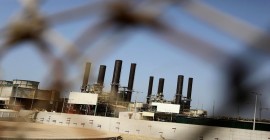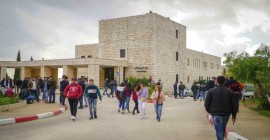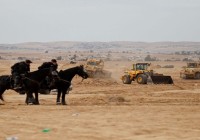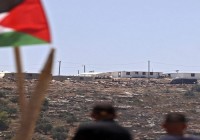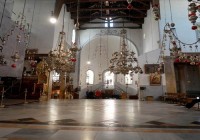The Reconstruction of Gaza is to take 7 Years with the Current Mechanism
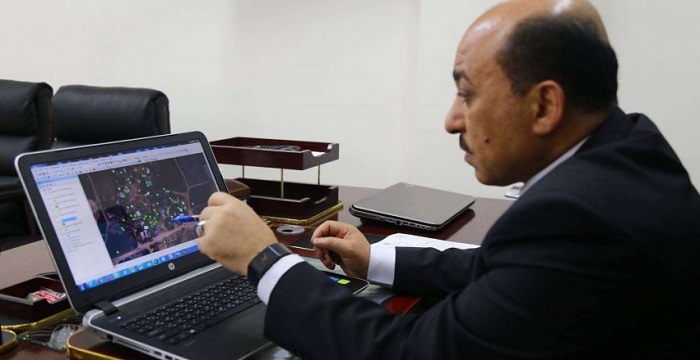
Islam Rady – Palestine Economy Portal
Translated by Tamara Barakat
The Minister of Public Works and Housing in Gaza, Mufid Al-Hasayna, warned that the reconstruction of the Gaza Strip might require more the seven years if the current mechanism for importing building materials to the Strip from Israel continues, as well as the shortage of the supply of such materials.
In an exclusive interview with the Palestine Economy Portal, Al-Hasayna stressed the necessity of fully lifting the Israeli blockade imposed on the Gaza Strip in order to ensure making real achievements in the reconstruction of the Strip, covering the increasing needs of the growing population, and the development of the infrastructure.
He affirmed that only 30% of the pledged funds for the reconstruction of the Gaza Strip have actually been received. He also addressed the latest details on the Kuwaiti and Qatari grants for the reconstruction, and the Ministry’s efforts to increase the amount of imported building materials to the Strip and remove the rubble.
Following is the transcript of the interview:
Q: After a year and a half, how do you evaluate the reconstruction of the Gaza Strip?
A: Unfortunately, a year and a half after the reconstruction of the Gaza Strip started, after the last Israeli aggression on the Strip, the reconstruction is not taking place as it should be because of the closing of the crossings, the prevention of importing the needed amounts of building materials, and the shortage of funding to the Strip.
The Israeli authorities have only allowed 200 thousand tons of cement to enter the Strip out of the 2 million tons that the Strip actually needs.
In the National Unity Government, we are constantly trying to place pressure on Israel to increase the amount of building materials allowed to enter the Strip. We have made some progress in this matter according to the plan of UN Middle East Envoy Robert Siri. We have also obtained approval from Israel to build more than 40 residential towers in the Strip. Also 1200 residential units have been built by the private sector (do not include the reconstruction of units destroyed in the most recent aggression).
As for the receipt of the pledged funds for the reconstruction of the Strip, we have received a Qatari grant for the construction of 1000 residential units, which we are close to completing. A Kuwaiti grant is also earmarked to funding the construction of 2110 residential units that were identified and evaluated by the Ministry and sent to the Ministry of Civil Affairs, and from there to the Israeli side who fully approved them. We are currently waiting for the funding to arrive in order to start the construction.
The Kingdom of Saudi Arabia has also pledged to fund the construction of another 1000 residential units.
Moreover, the Ministry of Public Works and Housing has succeeded in removing more than 97% of the wreckage in cooperation with the UNDP.
Q: How much of the pledged funds for the reconstruction of Gaza have actually been received?
A: In the Cairo Conference for the Reconstruction of the Gaza Strip, held in October 2014, 5.4 million dollars were pledged, half of which are allocated for the reconstruction of the Strip. However, we have only received 30% of those pledged funds until now. This is the main obstacle facing the Strip’s reconstruction, especially since the transfer of the funds requires measures based on each country’s laws.
Q: Why has the entry of building materials for those who have not been harmed by the Israeli aggression been halted since the start of December 2015?
A: Some cement was sold in the black market, but we are trying to solve this problem through coordination with the Ministry of Civil Affairs.
Currently, our efforts to resume importing building materials for finishing works have solved 70% of the problems and misunderstandings, and we are on our way to solving the rest of the problems regarding this matter.
Q: What is your response to the existence of a black market for building materials imported into the Strip?
A: No one can prevent a black market from existing for any product in the world, especially since what leads to the emergence of such a phenomenon is the citizens’ great need for cement in Gaza because of the shortages of the amounts imported.
Q: What is the progress in the projects funded by the Kuwaiti and Qatari grants?
A: We have fully completed 85% of 1000 residential units funded by the Qatari grant, and the remaining units are in the final stages of finishing works. We hope Qatar will fund the construction of another 1000 residential units to house more of those whose houses have been completely destroyed.
The Kuwaiti grant was not cancelled. We are currently communicating with the officials in Kuwait, and the technical matters regarding the grant are fully completed. The implementation of the construction of the 2110 residential units funded by the Kuwaiti grant will start soon.
Q: How much suffering is resulting from the shortage of residential apartments because of the delay in the reconstruction?
A: According to a study conducted by the Ministry of Public Works and Housing and UN organizations, the population of the Gaza Strip grows by 50 thousand people each year, and due to the past years of blockade and the last Israeli aggression, the Strip’s shortage of residential units amounted to 130 thousand units.
Q: Based on the current pace of the Gaza Strip’s reconstruction, how long do you expect it to need?
A: Any reconstruction requires two primary factors: funding and building materials. Once the funding is available, the reconstruction will require less than 3 years. Unfortunately, the blockade imposed on the Strip only allows 40% of the Strip’s needs of building materials to enter, and this will honestly greatly delay the reconstruction works. If the funding is not made available, the reconstruction of the Gaza Strip might take 6 to 7 years.
